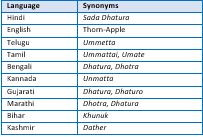Role of Dhatura according to Agad Tantra in Ayurveda
Keywords:
Vedic, Ayurveda, Agad, Dhatura, Upvisha, Atropine, Toxic, Anti-asthmatic.Abstract
Ayurveda is considered as one of the ancient health care systems. The antique Vedic texts have scattered references of Ayurvedic Remedies and allied aspects of medicine and health. Atharvaveda mainly deals with extensive Ayurvedic information. Agad Tantra is one of the eight branches of Ayurveda dealing with identification of poison, types of poison from minerals, plant and animal kingdoms as well as artificial poisons prepared from poisonous drugs and their treatment. Dhatura is one of the Upvisha. It is a wildly growing plant from the Solanaceae family, used in many Ayurvedic formulations. This plant has contributed various pharmacological actions in the scientific field of Indian systems of medicine like analgesic, anti-inflammatory, anti-asthmatic, hypoglycemic, anti-rheumatoid, and wound healing activities. It contains a variety of toxic tropane alkaloids such as atropine, hyoscyamine, scopolamine, etc. every part of the plant is toxic, but the highest number of alkaloids is contained in the seed. Dhatura poisoning is common in India. The administration of improper amounts of Dhatura affects the central nervous system with symptoms such as dysphagia, dementia, confusion, convulsions, delirium, and hallucination.
Downloads
References
Kirtikar JD, Basu BD. Indian medicinal plants. Allahabad: Lalit Mohan Basu, 1994; 1229-1231.
P.C. Sharma, Database on Medicinal Plants Used in Ayurveda, Volume 2, C CCRAS, New Delhi, 2005; Pg. 200.
Dr. Satish Chandra Sankyadhar, Sri Narhari Pandit’s Raj Nighantu, Chaukhambha Orientalia Varanasi, 1st Ed, 2012; P.482.
API, Part-1 Vol.4, First Edition, 2004, Govt. Of India Ministry of Health and Family Welfare Department of Ayush New Delhi.
Dr. J.L.N. Sastry, Illustrated Dravyguna Vijana, Vol.2, Chaukhambha Orientalia Varanasi, Reprint Ed, 2016; P.384.
B V Subrahmanyam, Parikh’s Textbook of Medical Jurisprudence, Forensic Medicine and Toxicology, Cbs Publishers & Distributors Pvt Ltd, 7th Ed, 2016; Ch. 54, P.635.
Dr. Sharad Porte, Agada Tantra Visha Chikitsa Vijana, 1 st Ed, 2016; Ch. 12, P.162.
Dr. K.S. Narayan Reddy, The Essential of Forensic Medicine & Toxicology, 34th Ed. 2017, Jaypee The Health Science Publisher New Delhi, Ch, 32, P.557.
VV Pillay, Textbook of Forensic Medicine & Toxicology, Paras Medical Publishers, 18th Ed. 2017, Ch, 35, P. 665.















